-
Posts
949 -
Joined
-
Last visited
Content Type
Profiles
Forums
Blogs
Gallery
Events
Store
Posts posted by David Gregory
-
-
This is a single full-size ribbon mounted on a robust brass bar:
[attachmentid=17191]
[attachmentid=17192]
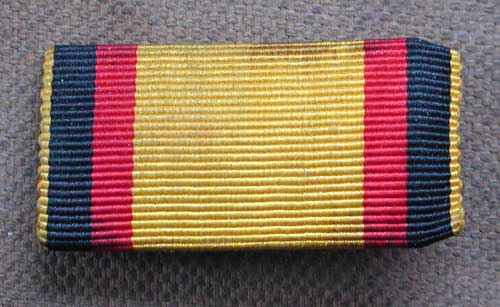
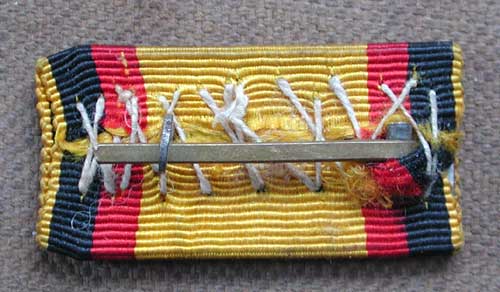

 0
0 -
The medal bar came with a matching ribbon bar:
[attachmentid=17188]
[attachmentid=17189]
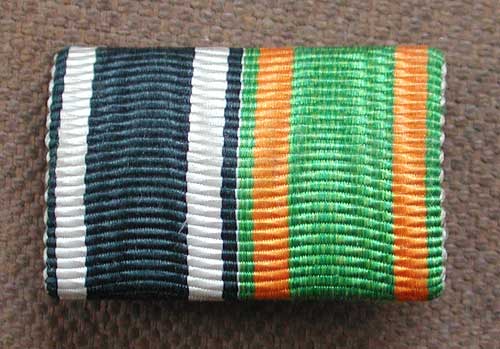
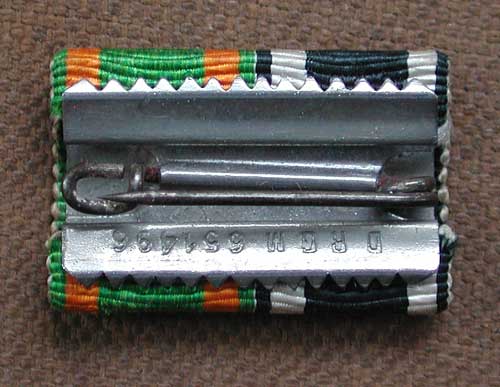

 0
0 -
I have shown an EK2 and Z?hringer L?we bar in a separate thread at http://gmic.co.uk/index.php?showtopic=3035&st=20
Here is another bar with a different style of construction.
[attachmentid=17184]
[attachmentid=17186]
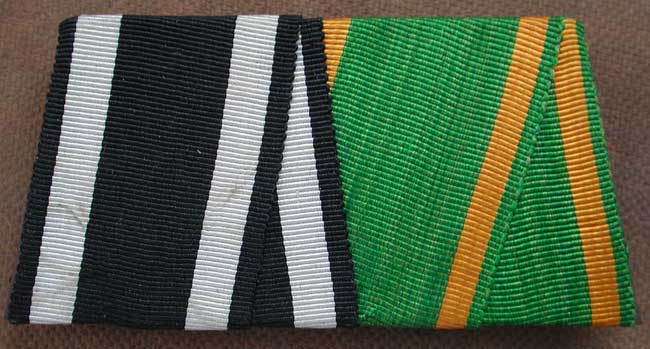
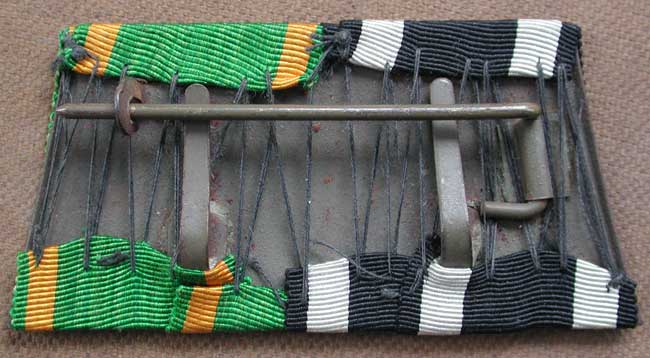

 0
0 -
This EK, Sachsen-Weimar, Reuss and DA ribbon bar, presumably to an NCO, has been shown elsewhere before, but I include it in this dedicated Reuss thread:
[attachmentid=17173]
This rather worn Saxon bar also features a Reuss ribbon and various devices. I assume it represents the following awards:
- EK
- Verdienstorden mit Schwertern (or perhaps the Verdienstkreuz?)
- Albrechtsorden Ritter mit Schwertern 2. Klasse
- Reuss Ehrenkreuz (which grade?)
- Frontk?mpfer-Ehrenkreuz
It measures only a few millimetres in height. Is this a style typical for Saxon bars? Would this bar be typical for a well decorated Leutnant or Oberleutnant? What would be the rank list abbreviations for these awards?
[attachmentid=17179]
[attachmentid=17180]
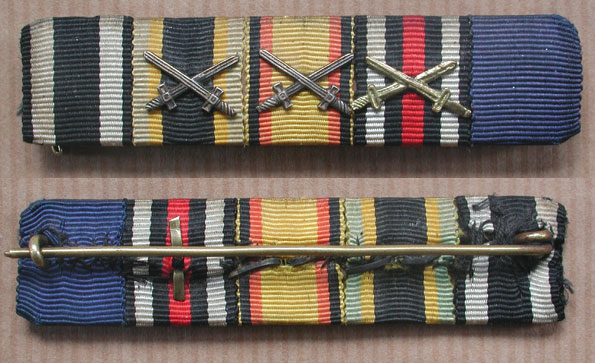




 0
0 -
Christian,
Unsigned or undated are not common, but they do exist.
Most of the documents I have are signed and dated, even the badly faded ones, but I have at least one example each of undated and unsigned iron cross award documents.
David
0 -
Chuck,
That is a very attractive award. Can you recommend any sites that explain Imperial Russian awards in simple terms or provide a good primer for further enquiries?
If I had the time, contacts and financial resources, this is another aspect of collecting militaria that I would like to pursue. Please consider a general lack of comments on my part as dumbstruck awe. Please show more, as I am sure there are many other collectors who simply know too little about them.
Thanks in advance,
David
0 -
have to agree with ed...
this is WORSE than using your salad fork for the entree...
nicely executed, poorly planned.
kinda' like gallipoli...
joe
 0
0 -
There's something mildly disturbing about a statue outside a school of an author of children's books wearing a long coat with his hands stuck in his pockets.
At least his hands are in HIS coat pockets.
0 -
Dave,
RIR 32 was raised in Gera and intially commanded by Oberstleutnant von Hering of IR 32 (KIA 7 September 1914).
- I. Bataillon was raised from men taken from IR 95 under the command of Major von Stockhausen
- II. Bataillon was raised from men taken from IR 96 under the command of Major Uhlenhaut
- III. Bataillon was raised from men taken from IR 95 under the command of Major von Hertell
RIR 252 was raised by Stellv. Gen. Kdo. XI. A. K. at Truppen-?bungs-Platz Ohrdruf from:
- Feldbataillon 57 in Sondershausen by Ersatz-Bataillon/IR 71
- Feldbataillon 58 in Coburg by Ersatz-Bataillon/IR 95
- Feldbataillon 59 in Rudolstadt by Ersatz-Bataillon/IR 96
- I. Bataillon under the command of Major Bachfeld
- II. Bataillon under the command of Hauptmann Grau
- III. Bataillon under the command of Major H?bner
Another unit with a probable Reuss contingent was Landsturm-Infanterie-Regiment Nr. 11, which was raised on 16 June 1916 by Stellv. Gen. Kdo. XI. A.K. and assigned to 8. Armee. Its two battalions were raised from Landsturm-Infanterie-Bataillon XI. 22 and Landsturm-Infanterie-Bataillon XI. 23. Replacements were provided by Ersatz-Bataillon/Landsturm-Infanterie-Regiment Nr. 11 (XI. 27) (Ohrdruf) and demobilised by IR 71.
Many Landwehr and Landsturm men from Reuss were used as replacements for various units throughout the war. Some units were raised in Gera and used elsewhere, e.g.:
- III./Landwehr-Infanterie-Regiment Nr. 71 commanded by Major a.D. Ulrich was raised in Gera
- 2. Landsturm-Infanterie-Bataillon Gera (XI. 13) was mobilised on 17 August 1914 and served with Gouvernement Belgien as part of 2. Armee
- 2. Landsturm-Infanterie-Bataillon Gera (XI. 25) was mobilised on 10 February 1916 and was assigned to 10. Armee, Armee-Abteilung D, Heeresgruppe Kiew, 1. bayerische Kavallerie-Division
This information was taken from Hartwig Busche's Formationsgeschichte der deutschen Infanterie im Ersten Weltkrieg 1914-1918.
I'll check my Milit?rpass entries for Reuss awards and add those later
David
0 -
Considering the level of destruction in German cities and the amount of displaced persons having to start from scratch in the immediate post-war period, it would not surprise me that there would be demand for replacement medals for ageing WW1 veterans.
That demand may have been met by surviving old stocks to a certain extent, but the major producers and suppliers would almost certainly have catered to the elderly vets as well as those willing to wear what they had been awarded in the 1939-45 period.
0 -
Rick,
Thanks for identifying the medal.
The photo came from German eBay some time in the last year or so and, if I recall correctly, was one for which I bid Euro 1 simply to mark it. No one else bid on it, so it inadvertantly became mine.
Only by checking the back of photos is it sometimes possible to reunite groups split and sold over a longer period of time. I wonder if our photos were taken within the same short time frame or in the same area.
I had assumed that the photographer was attached to a higher level unit such as a division or Korps somewhere on the Eastern front, much the same as some of the court photographers accompanied units from specific states (Mecklenburg, for example). I know next to nothing about the Russian OOB, but it would be interesting to find out when and where the Russian 102nd Infantry Regiment served and which German formation captured the NCOs. Judging by the state of dress of the men in both images, either the propaganda machine was hard at work or they do not seemed to have suffered much from the ravages of war when the photos were taken.
Has anyone a clue as to the badges the NCOs are wearing and does anyone have an example to show?
Many thanks in advance,
David
0 -
Paul,
I don't know about the crosses, but the medal is a veterans' association piece.
David
0 -
According to the printed caption written on the back, this photo was taken by
"Photo-Atelier Haase, G?hren a. R?g.Charlottenburg Tauroggenstr. 4.
z. Zt. im Felde".
The handwritten comment reads "Russians of the 102nd Regiment captured in Nowo-Alexandrowsky. 3 NCOs."
[attachmentid=16420]
Details from left to right:
[attachmentid=16421]
[attachmentid=16422]
[attachmentid=16424]
I assume that the medals and badges worn by all three men are the same. Unfortuanately, I have no other information on the context of this photograph. Any information on the awards would be greatly appreciated.
David
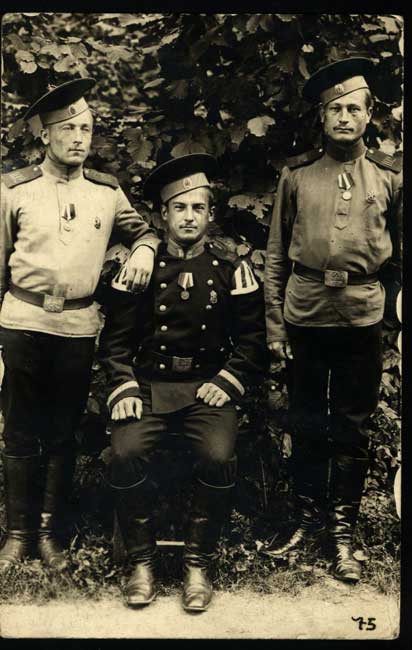
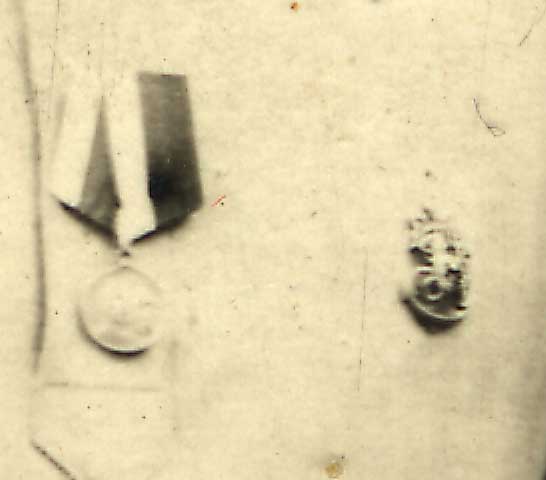
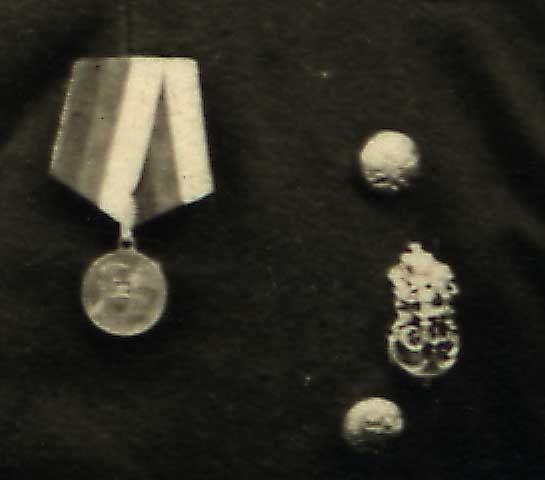








 0
0 -
Dave,
Thanks for showing the link to the 28. Infanterie-Division overview. Those pages have their own URL now which reads as follows:
http://www.militaerpass.net/28id.htm
If anyone wants anything specific on Grenadier-Regiment 110, I've got the regimental history.
Nice stuff guys.
Cheers,
David
0 -
Rick,
Thanks for the very informative reply.
Like many other collectors, I would be happy to acquire an authentic flight badge. However, this is one award for which no amount of homework will be too much before I part with any money.
The price you quote puts an entirely new perspective on it. A simple stamped steel issue piece, if it is good, can be had from a Hamburg dealer for less than Euros 400. Is that an indication that the badge is not good or are the issue pieces so much cheaper?
David
0 -
I assume the back will reveal more:
[attachmentid=15414]
The side:
[attachmentid=15415]
I assume from the crown mark that you do not like it. Was this one to avoid?
If so, what are tell-tale signs?
Many thanks in advance,
David

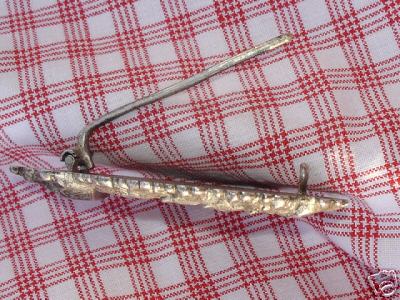

 0
0 -
Without wanting to start a new thread, was I right to ignore this one on German eBay aution #6222350636?
It sold for Euros 416.
[attachmentid=15411]
[attachmentid=15412]
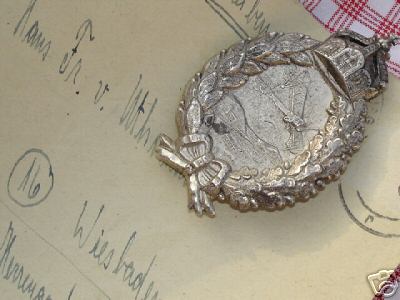


 0
0 -
Chris,
I'd leave it as it is. If you display the medal like the rest you have, the loop probably wouldn't be apparent as the ribbon would hide it.
Just a thought from someone who learned not to "improve" things by trying to return them to their original state (the hard way).
David
0 -
I recognise the Reuss medal, the Austrian cross and the Centenary medal, but that is about it.
This is also a new Mecklenburg-Schwerin court photographer for me, which makes at least three so far.
So, since I have a weakness for any related to Mecklenburg, who is he?
0 -
Chris,
A very nice selection and an instant French colonial collection.
Are there any variants of the Croix de Guerre that you don't yet have? Do you any nice 1914-15 or 1914-17 examples of the Croix de Guerre surplus to requirements?
Any ideas when and where the citation recipient was serving when he was killed and which German units were facing him?
Cheers,
David
0 -
Thanks Dave ..My Wife wants me to collect Postage Stamps because they take up less room !
She puts up with it though

That is an impressive collection, indeed, Mike.

To avoid conflicts with my other half due to the space taken up by field equipment, helmets and other hardware, I changed my collecting focus (mainly) to documents some time ago. However, researching documents requires a lot of literature, so I now have to justify the lack of bookshelf space. Never mind.
David
0 -
Dave,
Thanks for showing those awards, which are the sort of approximate front-line soldier's "equivalents" that I am looking for to match the German ones I have.
How do the earler and later Croix de Guerre types differ? Specifically, which are typically for 1914-18 and which are much later?
What are the other differences between the earlier and later orders apart from the language?
Many thanks in advance,
David
0 -
Laurence,
These are very attractive awards.
After only a passing interest, I abandoned Third Reich awards a few years ago (but paperwork still fascinates me). My main interest lies in Imperial German documents and the more common awards, but I have been led astray by some French and British awards and documents of the 1914-18 period.
With the exception of a victory medal, I still have nothing to represent Belgium's part in the Great War. This is another collecting field that is sorely tempting.
Do these awards date from that period or are they more recent? Were these awarded for merit or valour? Do you have examples of any award documents?
David
0 -
I am quite sure some type of international law is being broken by any one person having that many Anti Partisan Badges in their collection.........
Or Imperial flight bages, for that matter ...

 0
0




Show us your Reuss stuff!
in Germany: Imperial: The Orders, Decorations and Medals of The Imperial German States
Posted
This bar is typical for those worn by WW1 veterans after 1934. Most of them remain anonymous. However, this one came with the man's Milit?rpass, so it does have a story.
[attachmentid=17194]
[attachmentid=17195]
Albert Oskar K?rner (Oskar to his friends), was born in Tanna near Schleiz in the Principality of Reuss j?ngerer Linie on 19 January 1888. He was single and working as a plumber's assistant when he was called up as a replacement recruit and assigned to the recruit depot of the 1st replacement battalion of Reserve-Infanterie-Regiment 31 on 18 December 1914. In early March 1915, probably after completing his basic training, he was transferred to the 2nd replacement battalion of Infanterie-Regiment 85. Two weeks later, he joined the 7th company of Reserve-Infanterie-Regiment 98.
His regiment was part of 9. Reserve-Division and had been in the lines on the Verdun front since the beginning of December 1916. He was closely involved in the vicious fighting that took place when the Germans launched their assault in February 1916. His company was assigned to 10. Reserve-Division for the attack on the eastern edge of Cauri?res Wood on 25 February 1916, which resulted in the capture of Bezonvaux together with 243 prisoners and 8 machine-guns of French Infantry Rgiment 44.
Following initial successes, the German attack started to slow down and by early March, the battle had turned into a war of attrition. 9. Reserve-Division was involved in several attacks between 8 and 10 March to take Fort Vaux which, according to confusing reports, was captured by the Germans and then apparently retaken by the French. By the morning of 10 March, his battalion was so exhausted that it was relieved by elements of Reserve-Infanterie-Regiment 37. On 11 March, the division was withdrawn from the fighting. The respite was only short as, on 23 March, Oskar K?rner was badly injured as the result of being buried, probably in a trench that collapsed when bombarded by the French artillery.
He was evacuated to a dressing station at Jouvaincourt, where he remained for five days before being transported to a hospital in Germany. His injuries were so severe that he did not leave convalescent care until December 1916, when was assigned to a replacement unit. He was awarded his EK2 on 22 July 1916, almost certainly for the fighting at Verdun.
In January 1917 he was fit enough to return to active service and joined the newly raised Infanterie-Regiment 458, which was part of 236. Infanterie-Division and deployed to the new Sigfriedfront. He was involved in the fighting at Arras in May 1917 and all seemed to be going well for him until he was wounded in the left hand by shell splinters on 22 June 1917. After spending a month at Field Hospital 112, he returned to 12. Kompagnie in late July 1917. He spent the rest of 1917 fighting in French Flanders and Artois until the Spring Offensive in 1918, when he was involved in open warfare in Cambrai and on the Scarpe. From April until September 1918 he was either fighting in the Ypres salient or resting in the rear sector held by 4. Amee. In late October 1918 he was promoted to Gefreiter for bravery in the face of the enemy. He spent the last months of the war fighting on the Woevre Plain and in fighting retreats in Champagne and on the Maas. His war ended when he was discharged and returned to Reuss in early December 1918. He received the wound badge in black for two wounds on 18 May 1918 and was awarded his Reuss silver merit medal with swords as shown above on 25 May 1918.
My apologies for a slightly off-topic discourse, but some otherwise anonymous medal bars do have a story to tell.